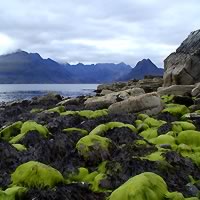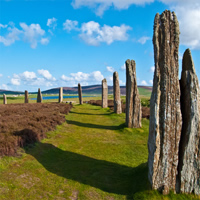Across the water from the Highlands are the Western Isles, broken down into the Inner and the Outer Hebrides, and Shetland and Orkney (although technically these are eastern). The islands are largely unpoilt, with amazing wildlife, fabulous beaches, lovely villages, delectable local produce, historic castles, dramatic scenery, and other fascinating attractions.
The largest isle of the Inner archipelago is Skye, made even more popular with its connection via bridge to the mainland. The Vikings called Skye 'The Cloud', and in Gaelic it was known as 'Eilean a` Cheo', 'or Island of the Mist'. No other island conjures the images of history and romance more than Skye. Its mountains and lakes evoke awe and legends are woven seamlessly into the very history of Scotland. Folklore claims that giants and fairies are responsible for some of the more unusual landmarks. Dunvegan Castle is sentinel of the staggering, bloody history between the feuding clans of Macleod and Macdonald. The caves hidden in the coast assisted the Macdonald clan in hiding Prince Charles Edward Stuart after the failed Jacobite rebellion. Many chiefs have ruled and fallen, leaving a wake of myths and relics waiting to be discovered.
Unsurprisingly, activities are centered around the outdoors. From rock climbing to pony trekking, walking, cycling, and bird watching, the breathtaking views will refresh and recharge your spirit. Even when the weather changes (as it frequently does), the island loses none of its charm. If anything, shrouded in light mists, the island takes on a more magical appeal. Learn the history of the island in one of many centers, visit the local potters, painters, or silversmiths to learn their trade, or just sit by a peat fire in an old pub with a glass of Talisker Whiskey, which is distilled right here on the island!
The Inner Hebrides continue further south, with the larger islands of Mull, Islay and Jura surrounded by dozens of smaller islands such as Ascrib Island, where magnificent puffer birds still reign supreme. The Isle of Iona is home to Iona Abbey, where many of Scotland's early Kings are interred. Islay is famous for its whisky, and Jura is where author George Orwell retreated, to Barnhill, to pen his masterpiece, '1984'. The home can still be visited today!
The Outer Hebrides, a glorious chain of islands, is made up of Harris, Lewis, and several smaller islands including North and South Uist, Barra and St. Kilda. Despite its relative proximity the mainland, one can't help but feel that you have arrived somewhere very special once reaching the islands. The islands have been inhabited, albeit intermittently, for 5,000 years, leaving behind some of the most dramatic monuments in Scotland. Crofters have adapted to the infertile land, with beds of seaweed and peat to grow their crops, and when the failed they turned to the sea. Living out here, at the edge of existence, has given the people of the Hebrides a unique fierceness and creativity.
Harris, whose east coast is a dramatic moonscape of volcanic rock, and whose west coast is made up of miles of golden sands, is joined by a thin strip of land at Tarbert. Here visitors can see the Tomb of Alisdair Crotach, one of the MacLeod clan, laid to rest at Rodel, near St. Clement's Church. The island Lewis holds the largest town in the Western Isles, Stornoway with its Museum Nan Eilean, as well as the Callanish Standing Stones. Abundant wildlife in or near the innumerable silver lochs of North Uist and Benbecula draw environmentalists. South Uist shelters the Banranald Nature Reserve and endangered greylag geese at Loch Druidbeg. Barra and Vatersay feature varying landscapes of moor, mountain, beach, and croft, and are known as the Garden of the Hebrides. Nearby, Dun Carloway Broch is one of the best preserved Iron Age brochs in Scotland. The uninhabited islands Mingulay and St. Kilda are full of sad, empty little makeshift villages, waiting in vain for their owners to return.
This prosperous community, however remote, has a ferocious pride in its Gaelic language and culture. Catch an impromptu 'ceilidh' (a traditional social gathering based around music and dance) in one of the lively local pubs or discover artifacts dating to the 7th century and treasures from a Viking burial.
Orkney is a bridge of islands, about 70 in total, of which only seventeen are populated. Though many of the Orkney Islands are small, there is something to see on virtually every one of them. For centuries they remained a Norse colony, however they had been inhabited long before the Vikings. There are nearly 3,000 Neolithic sites alone, including Skara Brae, the best preserved prehistoric village in Northern Europe, laid out long before the birth of Christ. Island hopping is a fantastic way to the experience the true sense of 'otherness' which the region retains amid the era of vast globalization. The Shetland Islands are a chain of about 100 islands, off the northeast coast of Scotland. The Shetland Islands have a long tradition of arts, crafts, and music. The large population of artisans make jewelry, leatherwork, woodcrafts, textiles and are manifest in fiddle playing, with an emphasis on heady spiritual, old fairy tunes and wild Norse strains. The Orkney annual Art's Celebration and St. Magnus Festival (with its inception in 1977), is regarded as one of the most exciting and thunderous in all of the UK. International talent such as Andre Previn, the Royal Philharmonic, and guitarist Julian Bream, in addition to local artists Tom Anderson, Catronia Macdonald, Fiddlers Bid, and more have requested to be included in the festival. Add to this the stunning natural scenery, tranquil beaches, tall cliffs, sheltered alcoves, and friendly people, and these two island chains become 'must visits' for anyone who truly wants to escape!


